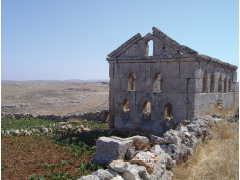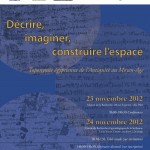Colloque international les 27-29 mars 2014 au collège de France.
L’Italie et l’Orient: Enjeux, échanges et regards croisés (Xe-XVIIe siècle)
Colloque international les 27-29 mars 2014 au collège de France.
L’Italie et l’Orient: Enjeux, échanges et regards croisés (Xe-XVIIe siècle)
Heaven and Earth: Greece’s Byzantium
May 1-3, 2014
Getty Villa in Malibu & UCLA in the Byzantine-Latino Quarter, Los Angeles
This symposium will bring together an internationally renowned group of scholars who will lecture at the Getty Villa, UCLA, and the Huffington Center at St. Sophia Cathedral. Focusing on Byzantine remains in Greece, this symposium foregrounds the important role of this region throughout late antiquity, the Middle Ages, and the Early Modern period. Sessions will focus on Byzantium’s roots in antiquity, issues of daily life, interactions with the Islamic world and with Italy, the meaning of icons, monumental art in Mystras and its periphery, and recent archaeological finds in Greece. The symposium will conclude with a film and discussion about traditional village life in Greece.
Speakers include Robert S. Nelson, Henry Maguire, Jas’ Elsner, Anthony Kaldellis, Elizabeth Marlowe, Ioli Kalavrezou, Maria Parani, Demetra Bakirtzi, Father Maximos Constas, Annemarie Weyl Carr, Alicia Walker, Maria Georgopoulou, Anastasia Drandaki, Michalis Kappas, Sean Roberts, Patricia Fortini Brown, Eugenia Gerousi, Sharon Gerstel and Barbara Drucker.
Registration information will appear shortly on the Getty website. For questions about hotels and logistics, email Sharon Gerstel (gerstel@humnet.ucla.edu)
The City and the cities: From Constantinople to the frontier
The Oxford University Byzantine Society’s
XVI International Graduate Conference
28th February – 1st March 2014, History Faculty, University of Oxford
The Classical Roman Empire has been described as an ‘empire of cities’, and both the reality and ideal of civic life remain central to its late-Antique and Medieval successor. Indeed, the term ‘Byzantine’ itself shows the importance placed by scholars on Constantine I’s refounding of Byzantion as the New Rome. Yet in 330 A.D. Constantinople was part of an urban landscape which included other, more ancient civic centres, whilst by 1453 A.D. little else remained but the City, itself a collection of villages and the Theodosian walls the frontier. Across this Byzantine millennium Constantinople was inextricably linked to the other cities of the empire, from the Golden Horn to the ever-shifting frontiers. With the apparent seventh-century disappearance of city-life in the broad new Anatolian borderlands, the strength of the Greek mainland in the twelfth century, and the rise of post-Byzantine cities in the old western frontiers of southern Italy and Venice, the vicissitudes of urban life in the empire are undoubtedly linked to each moment of change. Constantinopolitan artistic and architectural forms are fleshed in the local materials of Ravenna in the sixth century, and in the eleventh and twelfth centuries provincially-born men, educated in the City, become the bright lights of the so-called Komnenian Renaissance. Yet how are we to understand this dialectic between the City, the cities, and the imperial frontier? Moreover, what are the methodologies and conceptual frameworks which we might use to approach these issues?
We are calling for papers which explore the myriad approaches towards these issues, in all fields of Late Antique and Byzantine studies, including history, archaeology, history of art, theology, literature, intellectual history, and philology. Possible themes might include:
– Constantinople’s Place in the Empire
– The Changing Urban Landscape
– Civic and Provincial Art
– The Bishops and the Cities
– Civic and Provincial Intellectual Life
– The Civic Ideal and Imperial Citizenship
– Garrisoning the Cities, Guarding the Frontiers
Please send an abstract of no more than 250 words, along with a short academic biography in the third person, to the Oxford University Byzantine Society at byzantine.society@gmail.com by Friday, 29th November 2013. Papers should be 20 minutes in length, and may be delivered in English or French. For the first time the publication is in process of a selection of on-theme and inter-related papers from last year’s conference, having been chosen and reviewed by specialised readers from the University of Oxford’s Late Antique and Byzantine Studies department. We intend to do the same this year, and so any speakers wishing to have their papers considered for publication should try to be as on-theme as possible in their abstract and paper. Nevertheless, all submissions are warmly invited. More details will be sent to successful submissions soon after the deadline. Subject to funding, the OUBS hopes to offer subsidised accommodation for visiting speakers.
16-17 novembre 2012
Amphithéâtre,
Institut protestant de théologie
83, boulevard Arago,
75014 Paris
Programme en PDF
Vendredi 16 novembre
Matin
9h30 Françoise BRIQUEL CHATONNET (CNRS, Laboratoire Orient & Méditerranée) : Accueil et introduction
9h45 Widad KHOURY (DGAM SYRIE) ET Bertrand RIBA (doctorant, Laboratoire Orient & Méditerranée) : Les églises de Syrie : essai de synthèse
10h15 Jean-Luc BISCOP (Ministère de la culture, Laboratoire Orient & Méditerranée) : L’architecture des monastères anciens en Syrie et la place des églises
10h45 Pause
11h15 Widad KHOURY et Bertrand RIBA : Peut-on discerner des modèles liés à des communautés ecclésiales ou linguistiques ?
11h45 Elizabeth KEY FOWDEN (Wissenschaftskolleg zu Berlin) : Churches for the Arabs, churches for nomads ?
12h15 Françoise BRIQUEL CHATONNET : Que sait-on des églises par les textes ?
12h45 Buffet
Après-midi
14h30 Anne MICHEL (Université de Bordeaux) : Les églises de l’Arabia : particularités de structure et de répartition par rapport à la Syrie
15h Lévon NORDIGUIAN (Université Saint- Joseph, Beyrouth): Les églises anciennes de la montagne libanaise
15h30 Elif KESER KAYAALP (Mardin Artuklu University, Turquie) : Architecture in the Making: Evolution of the Churches and Monasteries in the Tur Abdin
16h Pause
16h30 Justine GABORIT : Mar Ya‘qub de Nisibe
17h Amir HARRAK (Université de Toronto) : Les églises de Mésopotamie
17h30 François CASSINGENA (Abbaye de Ligugé et Institut catholique de Paris) : Construction, destruction, inhabitation divine : Mystère et vie des églises à travers les écrits des premiers auteurs syriaques (IVe–VIe siècles)
Samedi 17 novembre
Matin
9h30 Vincent DÉROCHE (CNRS, Laboratoire Orient & Méditerranée) : Le site de Bazyan, Iraq
10h Florence HELLOT (Laboraroire Mondes iranien et indien, Paris) : Les églises d’Iran
10h30 Mgr Petros YOUSSIF (Institut catholique de Paris et Institut Pontifical, Rome) : Les églises comme cadre de la liturgie
11h Pause
11h30 Pier-Giorgio BORBONE (Università di Pisa) : Les églises d’Asie centrale et de Chine, essai de synthèse à partir des textes et des découvertes archéologiques
12h Jacob THEKEPARAMPIL (Saint Ephrem Ecumenical Research Institute, Kottayam, Inde) et Alain DESREUMAUX (CNRS, Laboratoire Orient & Méditerranée) : Les églises du Kérala (Inde)
12h30 Jean-Pierre SODINI (Académie des Inscriptions et Belles-Lettres) : Conclusions
13h Buffet
 Moyen-Âge
Moyen-ÂgeLieu : université Paris-Sorbonne (Paris-IV)
Organisation : Claire Somaglino (Paris-IV), Sylvain Dhennin (Ifao)
Le programme détaillé du colloque est disponible : Programme
Dans le cadre du programme « Systèmes toponymiques en Égypte de l’Antiquité au Moyen Âge »., développé par l’Institut français d’archéologie orientale du Caire en partenariat avec Paris-IV Sorbonne, seront organisés les 23 et 24 novembre 2012 un colloque international, une table-ronde et un atelier de formation à la toponymie.
23 novembre :
Session 1 : Légendes onomastiques et imaginaire de l’espace
Les noms de lieux sont des référents communs à une population donnée et, à ce titre, leur seule évocation raconte une histoire. Ces histoires appartiennent à la sphère collective et rendent l’espace intelligible. Lors d’un changement de langue, ou lors du passage d’un système toponymique à un autre, la perte du sens premier peut induire une remotivation des toponymes, qui aboutit régulièrement à la création de légendes onomastiques. Le rapport qu’établit une communauté avec les lieux qu’elle occupe peut en effet donner lieu à un récit, inventé ou réinventé, faisant appel à l’histoire, la religion ou la culture, et qui entretient le lien mémoriel avec l’espace.
Session 2 : Toponymie et description du paysage
La toponymie est un bon révélateur des relations entre l’homme et le paysage. Les noms de lieux sont en effet régulièrement formés autour de termes décrivant des éléments de ce paysage – eau, champ, reliefs, etc. Pas obligatoirement les plus caractéristiques d’ailleurs : cela peut être au contraire le nom d’une figure rare ou exceptionnelle, donc à ce titre marquante. L’évolution du paysage ne correspond pas non plus forcément à celui de la toponymie et celle-ci garde, sur le temps long, les traces d’états anciens du territoire et de sa mise en valeur. Ces références aux paysages livrent ainsi des informations précieuses sur la perception de l’espace, mais aussi et surtout sa construction et sa préservation dans les mémoires collectives, ou encore sur les manières de s’y repérer, de s’orienter. On s’interrogera alors sur des groupes de toponymes constitués autour de termes renvoyant au paysage, mais aussi sur le rôle de l’exploitation agricole et de la fiscalité dans la création toponymique, ou encore sur l’établissement de points de repères sur le long terme dans un paysage agricole changeant.
24 novembre (matin)
Table-ronde du programme Systèmes Toponymiques
Réunissant les participants au programme Systèmes Toponymiques, cette table-ronde permettra d’aborder les deux thématiques suivantes : définition d’un nom propre de lieu dans les différents systèmes toponymiques égyptiens ; nomenclature du vocabulaire employé pour former des toponymes.
24 novembre (après-midi)
Atelier de formation à la toponymie
Cet atelier aura pour but de sensibiliser les étudiants (Master-Doctorat) à la toponymie égyptienne des différentes périodes (Antiquité au Moyen-Âge) et de les former à ses méthodes. Après une introduction générale sur les caractéristiques de la toponymie de l’espace égyptien, une présentation des sources et des méthodes spécifiques à chaque période chronologique sera réalisée.